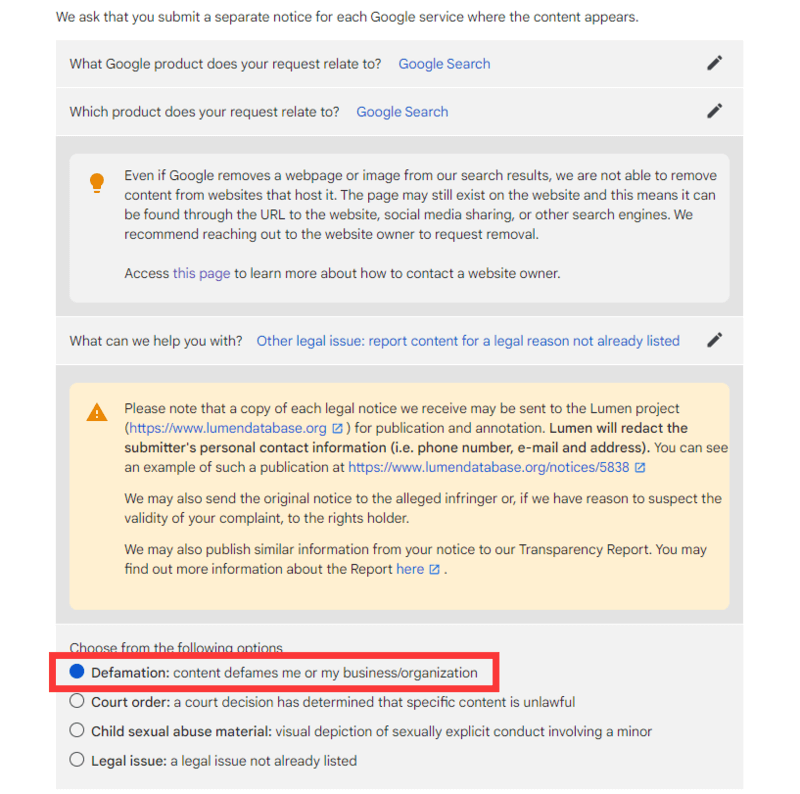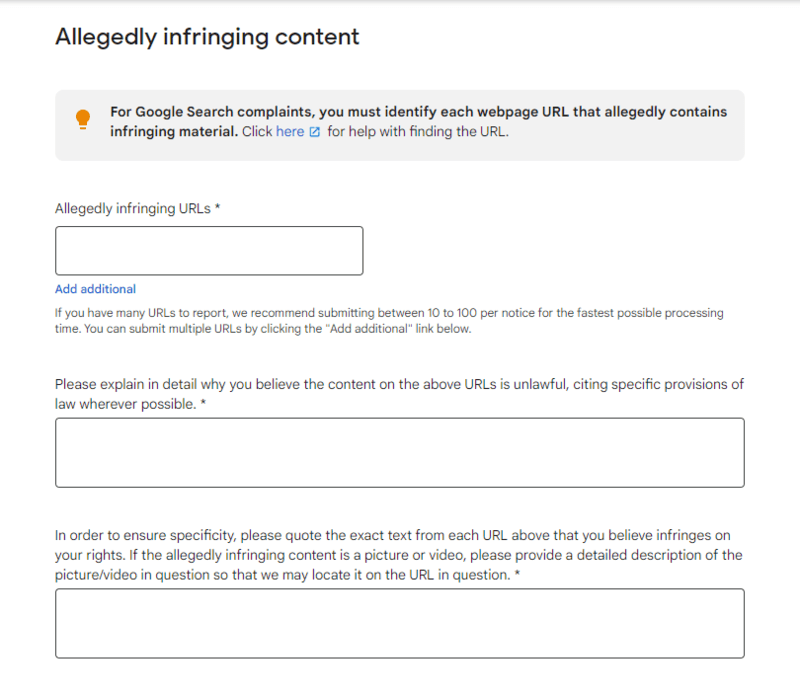How to Remove Defamatory Content from Google
Defamatory content in Google’s search results can be downright harmful for your own or your business’s reputation. Then, can we remove defamatory content from Google?
The good news is not only can you remove defamatory content from Google, but also you may have several options to get this job done.
This post will explain what is online defamation, why removing defamation information is important, and how to remove defamatory content from Google with 3 ways.

Contents
What Is Online Defamation?
Internet defamation is the online publication of a statement of fact that is verifiably false and that is harmful to your reputation. Internet defamation can occur in a negative Facebook post, a harmful YouTube video or even a fake and negative Google review about your business.
Towards an Individual
Defamation relates to the publication of information that adversely affects someone’s reputation. You may be familiar with the terms libel and slander, and these are both forms of defamation. Libel general referring to written statements, such as those within printed publications or placed online, while slander is all about the spoken word.
Towards a Business
Defamatory comments can also be made about a business or brand. The rules do differ in that it’s not enough just to make false comments that will affect the business’s reputation; it also has to be shown that it would or has the potential to cause a serious financial impact. With online sentiment (especially online reviews) forming such a key part of the modern consumer decision-making process, many businesses make serious efforts in removing defamatory content.
However, not all bad news online for you or your company are defamatory content. There are some situations where even if the content seems to be defamatory, there may not be the right for it to be removed. These include:
Truth
If the person who posted the content can show that the statement under question is true or it’s substantially true, then there is no case to be heard.
Honest Opinion
This used to be called ‘fair comment’, but it does exclude situations when there is malicious intent. For there to be a defense of honest opinion, it needs to be shown that:
- that the content was an opinion;
- that there is an apparent basis to the opinion;
- an honest person could also have formed that opinion
Public Interest
If someone feels that they are in a position whereby sharing content is necessary for moral, legal or social reasons, then they may call on the public interest defense within a defamation case. This could include situations where the material shared does later turn out to be incorrect, but at the time, they felt it was necessary to publish before verifying its accuracy.
Privilege
This defence covers situations in which a person has the right to make statements in quite specific circumstances. So this could include information provided within the setting of judicial proceedings.
Why Removing Defamatory Information is Important
When the defamation content rank high in the Google search results, the false or misleading statement can be spread widely and quickly.
For business owners, people who use Google to learn about your business end up finding the defamatory content, instead, hurting your reputation and deterring clients and customers. The financial loss that your business can suffer can be significant.
For individuals, defamatory content can cause harm to the person’s reputation, too.
How Can I Remove Defamatory Content from Google?
To remove defamatory content from Google, you can:
- Flag content that violates the law or Google’s Terms of Service and ask Google to de-index them. Google will typically remove content like non-consensual explicit images, copyrighted material or personal information (like financial or medical data) without the need for a court order.
- File a defamation lawsuit and obtain a court order requiring removal.
- Create “positive” content to make suppress the defamatory content and make them less visible.
Flagging defamatory content is free and easy, while obtaining a court order can be much more challenging. Therefore, I recommend you to ask Google to de-index defamatory content before filing a lawsuit.
Below, we take a more in-depth look at each of these removal options.
Method 1: Requesting The Removal of Defamatory Content from Google
If you’ve identified information that you believe to be defamatory, you may now need to make an application for removing that content with Google. Now, this is a step that in some circumstances requires no court order.
Here’s how to do it.
Step #1. Go to https://support.google.com/legal/troubleshooter/1114905?hl=en
Step #2. Choose what Google product does your request relate to. Here we choose “Google Search”.
Step #3. Choose one of the following options according to your situations,
- Remove personal information from Google under product policies (personally identifiable information, doxxing, non consensual explicit imagery, etc).
- Personal information: request removal of my personal information from Google’s search results.
- Other legal issue: report content for a legal reason not already listed > Defamation

Step #4. Create your request by filling the form.

Note: Defamatory content can be a little tricky to get removed from Google. That’s because its moderators are not in a position to act as a judge to decide whether or not the content meets the legal definition of defamation.
Defamation is a legal term, so that means that it is best assessed by those qualified within the applicable law and legislation. From a legal standpoint, defamation implies that a false statement has been published or communicated to a third party, and that has then caused damage to someone’s reputation.
However, there is little lost by reporting what you believe to be defamatory to see if Google will assist by removing content for you.
Method 2: Getting A Court Order for Defamatory Content Removal
Yes, you can also remove search results from Google with a court order to remove content.
If you do decide (or need) to go the court order route to get negative or defamatory content removed, there are a few things you need to know. Submitting a court order to Google is not a simple process. It can be time-consuming and costly.
In the simplest possible terms, obtaining a court order is a five-step process:
Step #1: Determine what legal claims you have and who you must sue. Make sure you need to have a court order to remove the content.
Step #2: After determining who authored the content, provide them with notice of your intent to sue. This gives the author an opportunity to voluntarily remove the content if they would like to avoid litigation.
Step #3: File a defamation lawsuit against the author of the content in the appropriate court. Technically, this step has multiple sub-steps and will likely be the most time-consuming component of obtaining a court order.
Step #4: Win your defamation lawsuit!
Step #5: Draft a comprehensive court order that meets Google’s criteria for removal. If you fail to adequately identify all of the content you want removed or do not draft an appropriate order, Google could reject the court order.
To meet Google’s criteria, a court order must include:
- Specific identification of the content to be removed or labeled as unlawful;
- Identification of the correct URL, platform, and website where the content is published;
- A statement that all similar content, whether published elsewhere or in a similar form, is also to be covered by the order to prevent re-posting; and
- Platform-specific language to ensure the hosting platform will honor the order.
Method 3: Suppress Defamatory Content
Suppression is a form of Search Engine Optimization (SEO) that involves building up and updating positive content in order to remove or suppress negative content off of first page search results.
If the search results do not violate Google’s policies against prohibited and restricted content, your best option is to push negative search results down by creating new, fresh content that far surpasses the negative results on Google.
Then, how to suppress negative content? High quality content is your key to suppressing negative search results. Most importantly, creating the content with SEO (Search Engine Optimization) in mind is the most important factor. This takes keyword research, competitor research, and specialized techniques and software.
Summary
Now, you know how to get defamatory content removed. The best practice to address the problem is without litigation which is costly and time-consuming. You can firstly contact the website owner about removal if the content is factually inaccurate. Or, you can ask Google to remove the defamatory content from search results.
If these efforts fail, contact an experienced attorney to discuss your rights.
